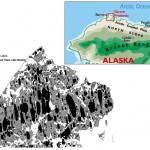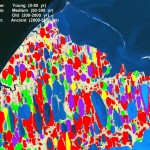Thaw lakes and vegetated thaw lake basins (VTLBs) are common features in permafrost zones and can comprise a large proportion of the land surface [1-7] (Figure 1). Thaw lakes on the Arctic Coastal Plain (ACP) of Alaska are estimated to have begun forming approximately 10,000 years ago in the Holocene when the climate was warmer and wetter than today [8, 9]. Initiation of drainage is thought to have begun about 5,000 years ago during the cooler, drier part of the Holocene [6, 10, 11]. Since that time the land surface of the ACP has undergone a slow, continuous, and overlapping cycle of lake drainage, vegetation succession, and lake re-formation, resulting in a collage of lakes and variously-aged VTLBs classified as young (< 50 yr), medium (50-300 yr), old (300-2000 yr), and ancient (2000-5500 yr) (Figure 2) [5, 6, 11-13].
Recent changes in thaw lake extent have been attributed to current global warming, but the net direction of change for continuous permafrost zones such as the ACP is still unclear [1, 2, 14-18]. While some studies have identified increasing numbers and extents of thaw lakes and ponds due to warming-induced thermokarst (thawing and subsidence of the ground surface) [2, 14, 19], others have documented decreases in lake extent due to increased evapotranspiration or sudden lake drainage via accelerated thermal erosion of outlet channels [16, 20]. Still others have found no long-term trend [15, 18, 21].
The future presence of thaw lakes and VTLBs is quite pertinent today under our current scenario of increasing global temperatures caused by rising atmospheric greenhouse gas concentrations. Northern permafrost regions contain vast stores of historically undecomposed organic material[22]. Thus, there is great concern that accelerated decomposition and associated release of greenhouse gases (CO2 and CH4) under a warmer climate may result in one of the largest feedbacks to climate change [23]. As indicated by recent studies, continued warming in this region will likely result in significant changes to thaw lakes, be it in the form of greater lake extent or drainage accompanied by edaphic and vegetation change through time. Either of these trajectories will likely affect the characteristics of primary productivity and organic matter decomposition for a large part of the Arctic Coastal Plain. The current collage of lakes and differently aged VTLBs on the ACP provides the opportunity to understand how millennial-scale ecosystem change alters the carbon balance of this system, which may aid in forecasting the response to future change. We plan to examine the CO2 and CH4 fluxes along this chronosequence for the Barrow Peninsula with low-flying flux aircraft, portable eddy covariance towers, and remote sensing measurements.
- Figure 1. Mapped Thaw Lakes and VTLBs for the Barrow Peninsula[7]. Upper right image shows general location, modified from WorldAtlas.com/GraphicMaps.com.
- Figure 2. Age-categorization of thaw lakes and VTLBs for the Barrow Peninsula[6].
References
1. Yoshikawa, K. and L.D. Hinzman, 2003. Shrinking thermokarst ponds and groundwater dynamics in discontinuous permafrost near council, alaska. Permafrost and Periglacial Processes, 14(2): p. 151-160.
2. Smith, L.C., et al., 2005. Disappearing arctic lakes. Science, 308(5727): p. 1429-1429.
3. Hussey, K.M. and R.W. Michelson, 1966. Tundra relief features near point barrow alaska. Arctic, 19(2): p. 162-184.
4. Black, R.F. and W.L. Barksdale, 1949. Oriented lakes of northern alaska. Journal of Geology, 57(2): p. 105-118.
5. Billings, W.D. and K.M. Peterson, 1980. Vegetational change and ice-wedge polygons through the thaw-lake cycle in arctic alaska. Arctic and Alpine Research, 12(4): p. 413-432.
6. Hinkel, K.M., et al., 2003. Spatial extent, age, and carbon stocks in drained thaw lake basins on the barrow peninsula, alaska. Arctic Antarctic and Alpine Research, 35(3): p. 291-300.
7. Frohn, R.C., K.M. Hinkel, and W.R. Eisner, 2005. Satellite remote sensing classification of thaw lakes and drained thaw lake basins on the north slope of alaska. Remote Sensing of Environment, 97(1): p. 116-126.
8. Kaufman, D.S., et al., 2004. Holocene thermal maximum in the western arctic (0-180 degrees w). Quaternary Science Reviews, 23(5-6): p. 529-560.
9. Anderson, P.M. and L.B. Brubaker, 1993. Holocene vegetation and climate histories of alaska. Global climates since the last glacial maximum: p. 386-400.
10. Mackay, J.R., Lake stability in an ice-rich permafrost environment:Examples from the western arctic coast., in Aquatic ecosystems in semi-arid regions: Implications for resource management, R.D. Robards and M.L. Bothwell, Editors. 1992, Environment Canada: Saskatoon, SK, Canada. p. 1-25.
11. Carson, C.E., 1968. Radiocarbon dating of lacustrine strands in arctic alaska. Arctic, 21(1): p. 12-26.
12. Everett, K.R., 1980. Distribution and variability of soils near atkasook, alaska. Arctic and Alpine Research, 12(4): p. 433-446.
13. Cabot, E.C., 1947. The northern alaskan coastal plain interpreted from aerial photographs. Geographical Review, 37(4): p. 639-648.
14. Walter, K.M., et al., 2006. Methane bubbling from siberian thaw lakes as a positive feedback to climate warming. Nature, 443(7107): p. 71-75.
15. Riordan, B., D. Verbyla, and A.D. McGuire, 2006. Shrinking ponds in subarctic alaska based on 1950-2002 remotely sensed images. Journal of Geophysical Research-Biogeosciences, 111(G4): p. 11.
16. Marsh, P., et al., 2009. Changes in thaw lake drainage in the western canadian arctic from 1950 to 2000. Hydrological Processes, 23(1): p. 145-158.
17. Labrecque, S., et al., 2009. Contemporary (1951-2001) evolution of lakes in the old crow basin, northern yukon, canada: Remote sensing, numerical modeling, and stable isotope analysis. Arctic, 62(2): p. 225-238.
18. Jones, B.M., et al., 2009. Arctic lake physical processes and regimes with implications for winter water availability and management in the national petroleum reserve alaska. Environmental Management, 43(6): p. 1071-1084.
19. Jorgenson, M.T., Y.L. Shur, and E.R. Pullman, 2006. Abrupt increase in permafrost degradation in arctic alaska. Geophysical Research Letters, 33(2).
20. Wolfe, B.B. and K.W. Turner, 2008. Near-record precipitation causes rapid drainage of zelma lake, old crow flats, northern yukon territory. Meridian: p. 7-12.
21. Plug, L.J., C. Walls, and B.M. Scott, 2008. Tundra lake changes from 1978 to 2001 on the tuktoyaktuk peninsula, western canadian arctic. Geophysical Research Letters, 35(3): p. 5.
22. Tarnocai, C., et al., 2009. Soil organic carbon pools in the northern circumpolar permafrost region. Global Biogeochemical Cycles, 23.
23. Schuur, E.A.G., et al., 2008. Vulnerability of permafrost carbon to climate change: Implications for the global carbon cycle. BioScience, 58(8): p. 701-714.


